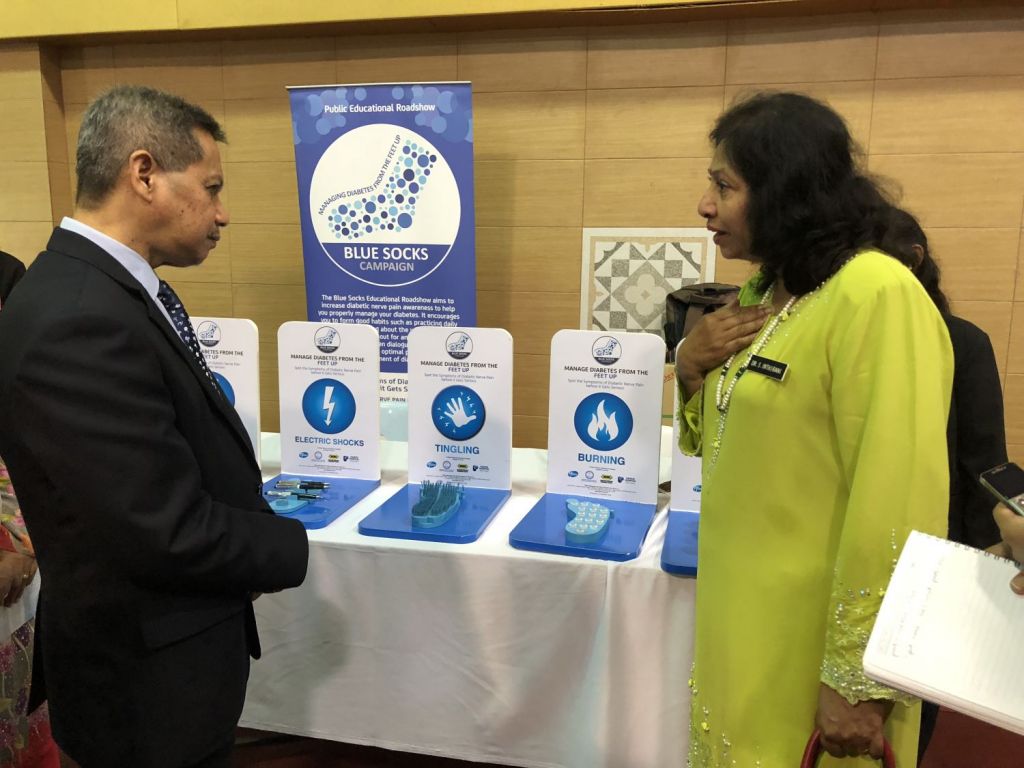KUALA LUMPUR, 31 January 2019 – Diabetes Malaysia recently concluded the Blue Socks public education roadshow, a six-city roadshow held across Malaysia with support from Pfizer Malaysia. Organised to raise awareness among diabetics, their families and the public on painful Diabetic Peripheral Neuropathy (pDPN), a common diabetes complication, the roadshow series kicked off in August 2018 in Kepong, Kuala Lumpur, followed by stops in Georgetown, Sandakan, Kuching, Johor Bahru and Seremban. In total, the roadshows were able to create awareness on pDPN among 787 visitors across all stops.
Often called the forgotten complication, pDPN – a type of neuropathic pain seen in patients with diabetic neuropathy, is one of the most frequent complications of diabetes. As many as one in five patients with diabetes may have pDPN, with symptoms including numbness, and burning and tingling (pins and needles) sensations[1]. pDPN can potentially lead to amputations as patients with the condition are more likely to develop foot ulcers due to unnoticed and untreated foot injuries[2].
At each of the one-day stop, the roadshow offered a wealth of diabetes related information to visitors, with activities including public forums, an exhibition on diabetes & diabetic foot care, booths sharing information on the symptoms of pDPN and complimentary foot screening stations. The nationwide Blue Socks public education roadshow, which aimed to educate Malaysians on the importance of foot care in managing diabetes, and to encourage diabetic patients to proactively seek medical help for pDPN as part of good diabetes management, was supported by Pfizer Malaysia since the launch of Blue Socks Campaign.

Nurses doing footcare test on one of the attendees at the forum
“In Malaysia, the burden of diabetes is a heavy one, with as many as 22.5% of adults having the condition[3]. Increasingly younger people are also being diagnosed. With diabetes being a progressive disease, it is more important than ever to ensure good disease management from the earliest stage, to avoid serious complications in later years. It is crucial to create greater awareness on pDPN, which is one of the most common diabetes complications and can result in amputation if untreated. Diabetic patients need to be educated to proactively inform their healthcare provider if they have any symptoms of pDPN, so it can be urgently treated before it worsens. Thus, the Blue Socks public education roadshow could be the effective eye opener to help diabetics maintain their mobility and independence in the long term. We find that the roadshow has an encouraging outcome and recommend to hold it at least annually,” said K.S. Maniam, Assistant General Secretary of Diabetes Malaysia.
“We are heartened that the Blue Socks public education roadshow was able to educate so many people around Malaysia about pDPN. At Pfizer, we believe in working together for a healthier world, and we are using initiatives such as this, in collaboration with Diabetes Malaysia to support diabetes patients and their families, with knowledge that helps them maintain a their quality of life through proper disease management and treatments. Through partnerships with organisations like Diabetes Malaysia that have a strong outreach framework, we want to optimise our combined strengths and resources for the greatest impact,” said Azwar Kamarudin, Corporate Affairs, Lead, Pfizer Malaysia.
Among the members of the public who visited the Blue Socks public education roadshow, many had never heard of pDPN and did not know they could seek treatment for the condition at the health centres catering to diabetics. They also had never received holistic foot care at the same centres, and thus found the lectures on foot care and the hands-on demonstrations extremely helpful. Meanwhile, through the information shared, the primary healthcare staff themselves became better informed about the seriousness of pDPN, and on the importance of conducting regular foot examinations for diabetic patients.
The Blue Socks campaign follows a compelling survey released in 2017 on the perception of patients and doctors on pDPN in Southeast Asia. The survey found that the top three reasons why patients in Malaysia waited for an average of 1.7 years after their first pain symptom before discussing it with their doctor were[4]:
- they were unaware that diabetes can cause pDPN
- they are fearful about the additional cost of treatment
- they have limited consultation time with their doctors, which prevented them from addressing their chronic pain issue
For more information about the Blue Socks Public Education Roadshow, please visit Diabetes Malaysia’s Facebook page at https://www.facebook.com/Diabetes-Malaysia-271686136235973/ or their website at http://diabetes.org.my/.
[1] Malik RA, et al. (2015). Treatment of painful diabetic neuropathy. Ther Adv Chronic Dis. 2015 Jan; 6(1): 15-28. [Online]. https://www.ncbi.nlm.nih.gov/pmc/articles/PMC4269610/
[2] Web MD, 13 March 2017, Can Diabetes Foot Problems Lead to Amputation?
https://www.webmd.com/diabetes/can-diabetes-foot-problems-lead-to-amputation#1. Accessed 27 December 2018
[3] National Health and Morbidity Survey 2015. Available at http://iku.moh.gov.my/index.php/research-eng/list-of-research-eng/iku-eng/nhms-eng/nhms-2015. Accessed 5 July 2018
[4] Malik RA, et al. (2017) Perceptions of Painful Diabetic Peripheral Neuropathy in South-East Asia: Results from Patient and Physician Surveys. Adv Ther. 2017; 34(6): 1426–1437. [Online]. Accessed on 27 November from https://www.ncbi.nlm.nih.gov/pmc/articles/PMC5487881/
















